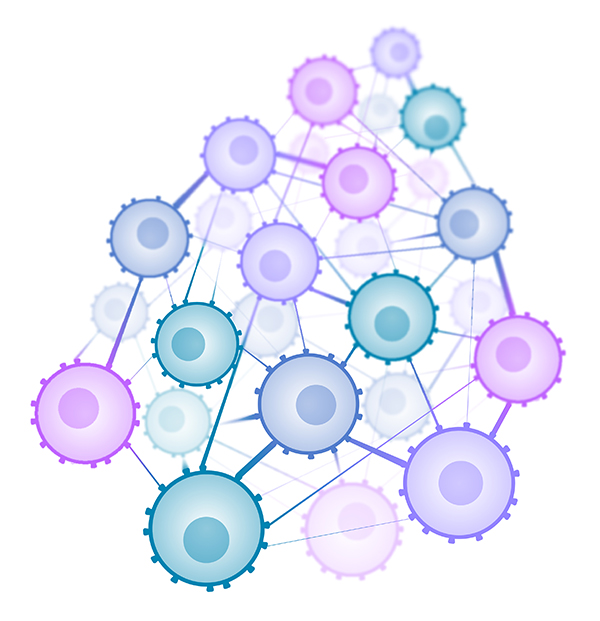Researchers unravel the social network of immune cells

Cells of the immune system need to communicate diligent with each other to defend successfully against diseases. Some cells send more informations than others, illustrated by differing line width. M. Krause, © MPI of Biochemistry
Facebook, Instagram, Twitter – nowadays, good social networking and communication is more important than ever. The immune system also resembles a large social network, as shown by Felix Meissner and his team in the Experimental System Immunology Research Group at the Max Planck Institute of Biochemistry in Martinsried.
With the help of proteomics they deciphered the messages exchanged between immune cells responsible for protecting us against diseases. In doing so, they have discovered complex cellular communication structures and previously unknown connections between various cell types. Their findings were published in the journal Nature Immunology.
Social networks such as Facebook now connect people around the globe, for the exchange of countless messages and pieces of information every day. Some people prefer to use social networks passively, only reading messages, while others have a strong need to communicate with others and tend to send out a large volume of information. The cells of our immune system work in a similar manner.
When cells wish to communicate with each other, they emit messengers, unique signal molecules, which are detected by other cells via cell surface receptors. These messengers disseminate information throughout the body to control immune reactions against pathogens. Some cell types are more communicative than others. “Innate immune cells such as macrophages are real chatterboxes,” Meissner says.
Meissner and his colleagues searched for messengers and their receptors on cell surfaces using mass spectrometry-based proteomics. For their study, the scientists first sorted a total of 28 different immune cell types, including macrophages and lymphocytes, from the blood of healthy individuals by means of flow cytometry. Each cell type has a different function in the immune system and therefore, communicates differently. By sorting the cells, the researchers were able to study the unique communication behaviour of each cell type separately.
This large-scale analysis revealed the intricate communication networks between immune cells. “Every cell has a distinct character. We can determine who tells whom what story and also who is not listening,” Meissner reports. The researchers have identified previously unknown communication pathways between cell types. They also showed that the pattern of messengers and receptors on the surface of immune cells can change. “A fungal infection, for example, gives rise to a different network than, say, a bacterial infection,” Meissner explains.
In the future, the researchers want to investigate how cells communicate within tissues and how cellular communication behaviour changes during complex diseases. (Sas)
Original publication:
J.Rieckmann, R.Geiger, D.Hornburg, T.Wolf, Ksenya Kveler, D.Jarropssay, F.Sallusto, S.Shen-Orr, A.Lanzavecchia, M.Mann, & F.Meissner: Social network architecture of human immune cells unveiled by quantitative proteomics, Nature Immunology, March 2017
DOI:10.1038/ni.3693
Contact:
Dr. Felix Meissner
Department Experimental Systems Immunology
Max-Planck-Institut of Biochemistry
Am Klopferspitz 18
82152 Martinsried
E-Mail: meissner@biochem.mpg.de
www.biochem.mpg.de/meissner
Dr. Christiane Menzfeld
Public Relations
Max Planck Institute of Biochemistry
Am Klopferspitz 18
82152 Martinsried
E-Mail: pr@biochem.mpg.de
http://www.biochem.mpg.de/meissner – Homepage Research Group Meissner
http://www.biochem.mpg.de – Homepage Max Planck Institute of Biochemistry
Media Contact
All latest news from the category: Life Sciences and Chemistry
Articles and reports from the Life Sciences and chemistry area deal with applied and basic research into modern biology, chemistry and human medicine.
Valuable information can be found on a range of life sciences fields including bacteriology, biochemistry, bionics, bioinformatics, biophysics, biotechnology, genetics, geobotany, human biology, marine biology, microbiology, molecular biology, cellular biology, zoology, bioinorganic chemistry, microchemistry and environmental chemistry.
Newest articles

Superradiant atoms could push the boundaries of how precisely time can be measured
Superradiant atoms can help us measure time more precisely than ever. In a new study, researchers from the University of Copenhagen present a new method for measuring the time interval,…

Ion thermoelectric conversion devices for near room temperature
The electrode sheet of the thermoelectric device consists of ionic hydrogel, which is sandwiched between the electrodes to form, and the Prussian blue on the electrode undergoes a redox reaction…

Zap Energy achieves 37-million-degree temperatures in a compact device
New publication reports record electron temperatures for a small-scale, sheared-flow-stabilized Z-pinch fusion device. In the nine decades since humans first produced fusion reactions, only a few fusion technologies have demonstrated…





















